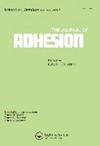Machine learning approach for analysing and predicting the modulus response of the structural epoxy adhesive at elevated temperatures
IF 2.3
4区 材料科学
Q2 ENGINEERING, CHEMICAL
引用次数: 0
Abstract
ABSTRACT For bonded Fibre Reinforced Polymer (FRP) strengthening systems in civil engineering projects, the adhesive joint performance is a key factor in the effectiveness of the strengthening; however, it is known that the material properties of structural epoxy adhesives change with temperature. This present paper examines the implied relationship between the curing regimes and the storage modulus response of the adhesive using a Machine Learning (ML) approach. A dataset containing 157 experimental data collected from the scientific papers and academic theses was used for training and testing an Artificial Neural Network (ANN) model. The sensitivity analysis reveals that the curing conditions have a significant effect on the glass transition temperatures (Tg ) of the adhesive, and consequently on the storage modulus response at elevated temperatures. Curing at an extremely high temperature for a long time does not, however, guarantee a better thermal performance. For the studied adhesive, curing in a warm (≥ 45°C) and dry (near 0 % RH) environment for 21 days is recommended for practical applications. A software with a Graphical User Interface (GUI) was established, which can predict the storage modulus response of the adhesive, plot the corresponding response curve, and estimate the optimum curing condition.用机器学习方法分析和预测结构环氧粘合剂在高温下的模量响应
摘要:对于土木工程中的粘结纤维增强聚合物(FRP)加固系统,粘结性能是影响加固效果的关键因素;然而,众所周知,结构型环氧胶粘剂的材料性能会随着温度的变化而变化。本文使用机器学习(ML)方法研究了粘合剂的固化状态和储能模量响应之间的隐含关系。使用包含从科学论文和学术论文中收集的157个实验数据的数据集来训练和测试人工神经网络(ANN)模型。敏感性分析表明,固化条件对粘合剂的玻璃化转变温度(Tg)有显著影响,因此对高温下的储能模量响应有显著影响。然而,在极高温度下长时间固化并不能保证更好的热性能。对于所研究的粘合剂,建议在温暖(≥45°C)和干燥(接近0%RH)的环境中固化21天,以供实际应用。建立了一个具有图形用户界面(GUI)的软件,该软件可以预测胶粘剂的储能模量响应,绘制相应的响应曲线,并估计最佳固化条件。
本文章由计算机程序翻译,如有差异,请以英文原文为准。
求助全文
约1分钟内获得全文
求助全文
来源期刊

Journal of Adhesion
工程技术-材料科学:综合
CiteScore
5.30
自引率
9.10%
发文量
55
审稿时长
1 months
期刊介绍:
The Journal of Adhesion is dedicated to perpetuating understanding of the phenomenon of adhesion and its practical applications. The art of adhesion is maturing into a science that requires a broad, coordinated interdisciplinary effort to help illuminate its complex nature and numerous manifestations.
 求助内容:
求助内容: 应助结果提醒方式:
应助结果提醒方式:


